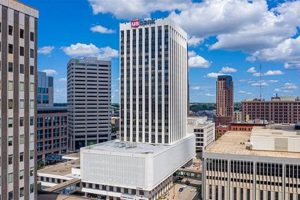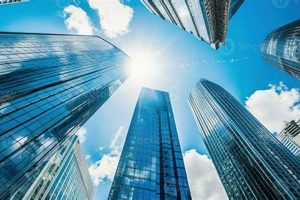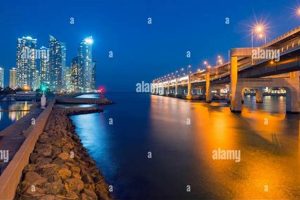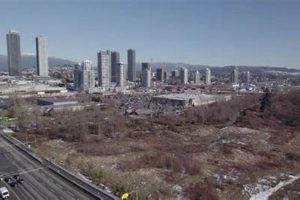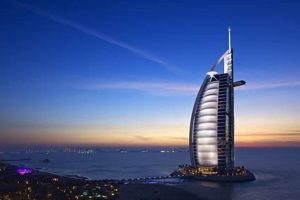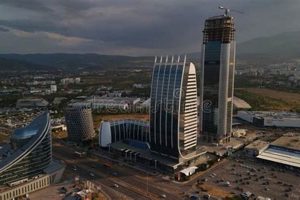Hong Kong’s skyscrapers are a defining feature of the city’s skyline and a major part of its identity. The city is home to some of the tallest buildings in the world, including the International Commerce Centre, the Two International Finance Centre, and the Central Plaza. These skyscrapers are not only architectural marvels but also important economic and cultural landmarks.
The development of skyscrapers in Hong Kong began in the 1950s and 1960s, as the city’s population and economy boomed. The construction of these buildings was driven by the need for more office space and residential units. The first skyscrapers in Hong Kong were relatively short, but as the city grew, so did the height of its buildings.
Today, Hong Kong’s skyscrapers are a major part of the city’s economy. They provide office space for many of the city’s businesses and generate revenue from tourism. The skyscrapers are also a popular destination for tourists, who come to admire their architecture and enjoy the views from their observation decks.
1. Height
The height of Hong Kong’s skyscrapers is a major contributing factor to the city’s iconic skyline. The city is home to some of the tallest buildings in the world, including the International Commerce Centre, the Two International Finance Centre, and the Central Plaza. These buildings are not only architectural marvels but also important economic and cultural landmarks.
- Economic Impact: The height of Hong Kong’s skyscrapers has a significant impact on the city’s economy. The buildings provide office space for many of the city’s businesses, and they generate revenue from tourism. The skyscrapers also attract investment from around the world, which helps to boost the city’s economy.
- Cultural Significance: The skyscrapers of Hong Kong are a major part of the city’s culture and identity. The buildings are often featured in films and television shows, and they are a popular destination for tourists. The skyscrapers are also a symbol of Hong Kong’s economic power and its commitment to innovation.
- Engineering Challenges: The height of Hong Kong’s skyscrapers presents a number of engineering challenges. The buildings must be designed to withstand high winds and earthquakes, and they must be able to support the weight of thousands of people and tons of equipment. The engineers who design these buildings must be highly skilled and experienced.
- Environmental Impact: The height of Hong Kong’s skyscrapers also has an environmental impact. The buildings can block sunlight from reaching the streets below, and they can create wind tunnels that can be dangerous for pedestrians. The buildings also consume a lot of energy, which can contribute to air pollution.
The height of Hong Kong’s skyscrapers is a major factor in the city’s economy, culture, and environment. The buildings are a symbol of Hong Kong’s economic power and its commitment to innovation. However, the buildings also present a number of engineering and environmental challenges that must be carefully considered.
2. Architecture
The architecture of Hong Kong’s skyscrapers is a reflection of the city’s diverse cultural influences and its commitment to innovation. The city’s skyscrapers are designed in a variety of architectural styles, from modern to postmodern, and they often incorporate elements from both Eastern and Western cultures.
- Modern Architecture: Many of Hong Kong’s skyscrapers are designed in the modern style, which emphasizes simplicity, functionality, and the use of glass and steel. Some notable examples of modern architecture in Hong Kong include the Bank of China Tower and the HSBC Main Building.
- Postmodern Architecture: Postmodern architecture is a reaction against the simplicity and functionality of modern architecture. Postmodern buildings are often more playful and eclectic, and they may incorporate elements from different architectural styles. Some notable examples of postmodern architecture in Hong Kong include the Lippo Centre and the International Finance Centre.
- Chinese Influences: Many of Hong Kong’s skyscrapers incorporate elements of traditional Chinese architecture. These elements may include the use of feng shui principles, the use of traditional Chinese motifs, and the use of red and gold colors. Some notable examples of skyscrapers in Hong Kong that incorporate Chinese influences include the Bank of East Asia Headquarters and the Nina Tower.
- Western Influences: Hong Kong’s skyscrapers also incorporate elements of Western architecture. These elements may include the use of classical Greek and Roman motifs, the use of Gothic arches, and the use of stained glass windows. Some notable examples of skyscrapers in Hong Kong that incorporate Western influences include the Hong Kong Club Building and the Peninsula Hotel.
The variety of architectural styles found in Hong Kong’s skyscrapers is a reflection of the city’s unique cultural heritage and its commitment to innovation. The skyscrapers are not only functional buildings but also works of art that contribute to the city’s vibrant and cosmopolitan atmosphere.
3. Function
Skyscrapers in Hong Kong are not only iconic landmarks but also serve a variety of essential functions that contribute to the city’s economic growth, vibrant urban environment, and overall quality of life.
- Office Space: Skyscrapers in Hong Kong provide a significant amount of office space for businesses of all sizes, from local startups to multinational corporations. The city’s central business district, Central, is home to many of Hong Kong’s tallest skyscrapers, which house the headquarters of major banks, financial institutions, and other companies.
- Residential Units: Skyscrapers in Hong Kong also provide a substantial number of residential units, ranging from luxury apartments to affordable housing. Living in a skyscraper offers residents stunning views of the city, easy access to amenities, and convenient transportation options.
- Retail Space: Skyscrapers in Hong Kong often include retail space on the lower floors, offering a wide range of shopping options for residents, workers, and tourists alike. These retail spaces include everything from high-end boutiques to convenience stores, catering to the diverse needs of the city’s population.
- Mixed-Use Developments: Many skyscrapers in Hong Kong are mixed-use developments that combine multiple functions within a single building. These developments may include a mix of office space, residential units, retail space, and even pu
blic amenities such as parks or schools. Mixed-use developments promote urban density, reduce commuting times, and create more vibrant and livable neighborhoods.
The diverse functions served by skyscrapers in Hong Kong contribute to the city’s overall economic prosperity, livability, and global competitiveness. These buildings are not only architectural marvels but also essential components of Hong Kong’s urban fabric, providing a wide range of spaces for businesses, residents, and visitors.
4. Economics
The skyscrapers of Hong Kong are a major part of the city’s economy. They provide office space for many of the city’s businesses, and they generate revenue from tourism. The city’s central business district, Central, is home to many of Hong Kong’s tallest skyscrapers, which house the headquarters of major banks, financial institutions, and other companies. These businesses contribute significantly to the city’s economy, and they rely on the skyscrapers to provide them with the space they need to operate.
In addition to providing office space, the skyscrapers of Hong Kong also generate revenue from tourism. Many of the city’s skyscrapers have observation decks that offer stunning views of the city. Tourists from all over the world come to Hong Kong to visit these observation decks, and they spend money on tickets, souvenirs, and other goods and services. The revenue generated from tourism helps to support the city’s economy.
The skyscrapers of Hong Kong are a major part of the city’s economy. They provide office space for many of the city’s businesses, and they generate revenue from tourism. The economic benefits of these buildings are significant, and they help to make Hong Kong one of the most prosperous cities in the world.
5. Culture
The skyscrapers of Hong Kong are not just architectural marvels but also cultural icons that have captured the imagination of people around the world. Their unique designs and impressive heights have made them a popular destination for tourists and a backdrop for numerous films and television shows.
- Tourism: The skyscrapers of Hong Kong are a major tourist attraction. Visitors from all over the world come to see these iconic buildings and to experience the city’s vibrant atmosphere. Many of the skyscrapers have observation decks that offer stunning views of the city, and tourists can also take guided tours of some of the buildings.
- Film and Television: The skyscrapers of Hong Kong have been featured in numerous films and television shows. The city’s unique skyline has made it a popular location for action movies, science fiction films, and romantic comedies. Some of the most famous films that have featured the skyscrapers of Hong Kong include “The Dark Knight,” “Transformers: Age of Extinction,” and “Lost in Translation.”
- Cultural Symbolism: The skyscrapers of Hong Kong are a symbol of the city’s economic power and its status as a global financial center. They are also a symbol of the city’s cultural diversity and its unique blend of East and West. The skyscrapers of Hong Kong are a reminder of the city’s rich history and its bright future.
The cultural significance of the skyscrapers of Hong Kong cannot be overstated. They are a major tourist attraction, a backdrop for numerous films and television shows, and a symbol of the city’s economic power and cultural diversity. The skyscrapers of Hong Kong are a reminder of the city’s rich history and its bright future.
6. Sustainability
Sustainability has become an increasingly important consideration in the design and construction of skyscrapers in Hong Kong. Many of the city’s newest skyscrapers are equipped with a range of sustainable features, such as green roofs, rainwater harvesting systems, and energy-efficient lighting. These features help to reduce the environmental impact of these buildings and make them more sustainable in the long term.
Green roofs are a popular sustainable feature in Hong Kong’s skyscrapers. These roofs are covered in vegetation, which helps to insulate the building, reduce stormwater runoff, and improve air quality. Rainwater harvesting systems collect rainwater from the roof and store it for later use, which can help to reduce the building’s water consumption. Energy-efficient lighting systems use less energy than traditional lighting systems, which can help to reduce the building’s carbon emissions.
The sustainability features in Hong Kong’s skyscrapers are not only good for the environment, but they can also be good for business. Green roofs and rainwater harvesting systems can help to reduce the building’s operating costs, and energy-efficient lighting systems can help to reduce the building’s carbon footprint. As a result, sustainable skyscrapers are becoming increasingly popular with tenants and investors alike.
The sustainability features in Hong Kong’s skyscrapers are a testament to the city’s commitment to environmental sustainability. These features are helping to reduce the environmental impact of the city’s buildings and make them more sustainable in the long term.
7. Innovation
Hong Kong’s skyscrapers are not just architectural marvels, but also showcases for the latest innovations in building design and technology. Architects and engineers in Hong Kong are constantly pushing the boundaries of what is possible, developing new ways to make skyscrapers more efficient, sustainable, and resilient.
- Green building technologies: Hong Kong’s skyscrapers are often equipped with the latest green building technologies, such as solar panels, wind turbines, and rainwater harvesting systems. These technologies help to reduce the environmental impact of the buildings and make them more sustainable in the long term.
- Smart building technologies: Smart building technologies are also becoming increasingly common in Hong Kong’s skyscrapers. These technologies allow building managers to monitor and control the building’s systems remotely, which can help to improve efficiency and reduce operating costs.
- New design features: Hong Kong’s skyscrapers are also often notable for their innovative design features. For example, some skyscrapers have been designed with sky gardens or green terraces, which provide tenants with access to outdoor space without having to leave the building.
- Mixed-use developments: Mixed-use developments are becoming increasingly popular in Hong Kong. These developments combine different types of uses, such as residential, commercial, and retail, into a single building. This can help to create more vibrant and sustainable communities.
The innovation that is taking place in Hong Kong’s skyscrapers is helping to shape the future of building design and technology. These buildings are not only architectural marvels, but also test beds for new ideas that could one day be used in skyscrapers around the world.
8. Recognition
The recognition that Hong Kong’s skyscrapers have received for their design and innovation is a testament to the city’s commitment to architectural excellence. These awards and accolades not only recognize the individual buildings themselves but also highlight the city’s overall reputation as a center of innovation and creativity.
- Prestigious Awards: Hong Kong’s skyscrapers have won some of the most prestigious awards in the world of architecture, including the Council on Tall Buildings and Urban Habitat (CTBUH) Best Tall Building Award and the International Architecture Award. These awards recognize the buildings’ overall design, innovation, and contribution to the urban environment.
- Recognition for Sustainability: Many of Hong Kong’s skyscrapers have also been recognized for their sustainability features. The CTBUH has awarded several of the city’s skyscrapers with its Sustainability Award, which recognizes buildings that demonstrate a commitment to environmental sustainability and energy efficiency.
- Recognition for Innovation: Hong Kong’s skyscrapers are often recognized for their innovative design features. For example, the International Skyrise Greenery Award has been awarded to several of the city’s skyscrapers for their innovative use of greenery and landscaping.
- Contribution to Hong Kong’s Skyline: The recognition that Hong Kong’s skyscrapers have received has helped to raise the city’s profile as a global architectural hub. The city’s skyline is now one of the most recognizable in the world, and its skyscrapers are a major tourist attraction.
The recognition that Hong Kong’s skyscrapers have received for their design and innovation is a testament to the city’s commitment to architectural excellence and innovation. These awards and accolades not only recognize the individual buildings themselves but also highlight the city’s overall reputation as a center of innovation and creativity.
FAQs on “Skyscrapers of Hong Kong”
This section addresses frequently asked questions regarding the skyscrapers of Hong Kong, providing concise and informative answers.
Question 1: What is the tallest skyscraper in Hong Kong?
Currently, the tallest skyscraper in Hong Kong is the International Commerce Centre, standing at 484 meters tall with 118 floors.
Question 2: Are the skyscrapers in Hong Kong earthquake-resistant?
Yes, skyscrapers in Hong Kong are designed and built to withstand earthquakes. Hong Kong is located in an earthquake-prone region, and buildings are required to meet strict building codes to ensure safety during seismic events.
Question 3: Do any of the skyscrapers in Hong Kong have green features?
Yes, many skyscrapers in Hong Kong incorporate green features, such as solar panels, rainwater harvesting systems, and green roofs. These features promote sustainability and reduce the environmental impact of these buildings.
Question 4: Are there any observation decks in the skyscrapers of Hong Kong?
Yes, several skyscrapers in Hong Kong have observation decks that offer panoramic views of the city. The most popular observation decks include the Sky100 Observation Deck at the International Commerce Centre and The Peak Tower.
Question 5: Can tourists visit the skyscrapers in Hong Kong?
Yes, tourists can visit some of the skyscrapers in Hong Kong. Guided tours are available for certain buildings, and observation decks are open to the public for a fee.
Question 6: What is the average height of skyscrapers in Hong Kong?
The average height of skyscrapers in Hong Kong is approximately 150 meters (492 feet). However, there is a wide range of heights, with some buildings reaching over 400 meters (1,312 feet).
In summary, the skyscrapers of Hong Kong represent architectural marvels that contribute to the city’s skyline and play a significant role in its economy and tourism. These buildings are designed to be safe, sustainable, and innovative, offering breathtaking views and unique experiences to visitors.
Transition to the next article section.
Skyscrapers of Hong Kong
Visiting the skyscrapers of Hong Kong is an unforgettable experience that offers breathtaking views and a glimpse into the city’s architectural marvels. Here are a few tips to make the most of your visit:
Tip 1: Plan Your Visit
Research the different skyscrapers and choose those that align with your interests and budget. Consider the opening hours, admission fees, and any special events or exhibitions.Tip 2: Book Observation Deck Tickets in Advance
Observation decks often have limited capacity, especially during peak season. Secure your tickets online or through authorized agents to avoid disappointment and long queues.Tip 3: Arrive Early
Arrive at the skyscraper early, particularly during weekends or holidays, to avoid crowds and capture the best views. This will give you ample time to explore the building and its amenities.Tip 4: Take Advantage of Guided Tours
Many skyscrapers offer guided tours that provide insights into their history, design, and engineering. These tours are informative and enhance the overall experience.Tip 5: Explore the Surrounding Area
Don’t just limit your visit to the skyscraper itself. Take some time to explore the surrounding area, which may offer additional attractions, shopping malls, or dining options.Tip 6: Consider Visiting at Different Times
Visit the skyscrapers at different times of the day to experience varying views. During the day, you can appreciate the city’s bustling atmosphere, while at night, the illuminated skyline creates a magical ambiance.Tip 7: Respect Building Rules and Regulations
Observe the rules and regulations of each skyscraper, including dress codes, photography restrictions, and designated smoking areas. Be respectful of the staff and other visitors.Tip 8: Allow Ample Time for Your Visit
Set aside sufficient time to fully explore the skyscraper and its observation deck. Allow for potential queues, time to relax and soak in the views, and any additional activities you may want to engage in.
By following these tips, you can optimize your visit to the skyscrapers of Hong Kong, ensuring a memorable and enriching experience.
Transition to the article’s conclusion.
Conclusion
The skyscrapers of Hong Kong are a testament to the city’s economic power, architectural prowess, and commitment to innovation. These towering structures have reshaped the city’s skyline, becoming iconic landmarks that symbolize Hong Kong’s status as a global financial and cultural hub.
From their impressive heights and diverse architectural styles to their sustainable features and innovative designs, the skyscrapers of Hong Kong stand as remarkable achievements in modern architecture. They not only provide essential office and residential space but also serve as tourist attractions, offering breathtaking views and unique experiences.
As Hong Kong continues to grow and evolve, its skyscrapers will undoubtedly play a pivotal role in shaping the city’s future. They represent the city’s ambition, resilience, and unwavering pursuit of excellence. The skyscrapers of Hong Kong are not just buildings; they are symbols of a city that is constantly reaching for the sky.


